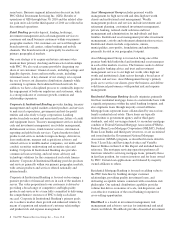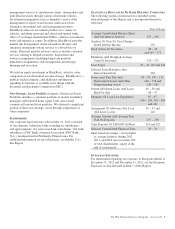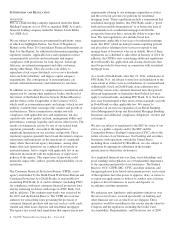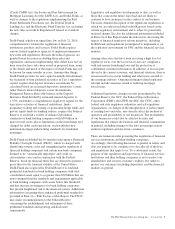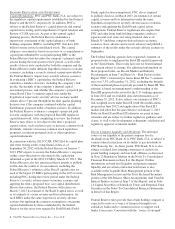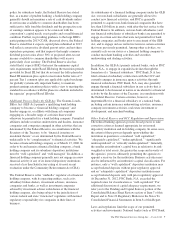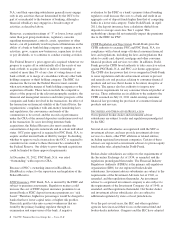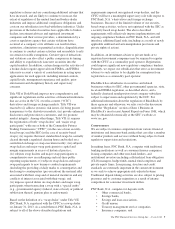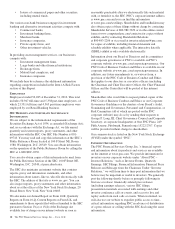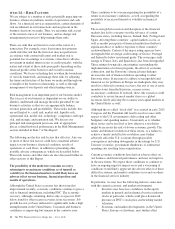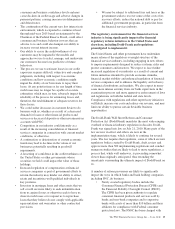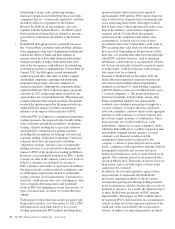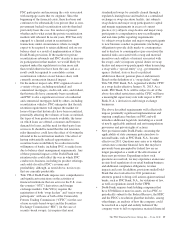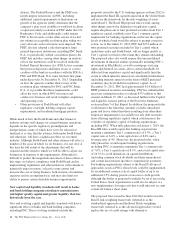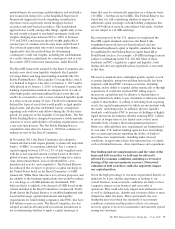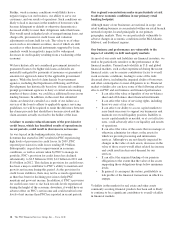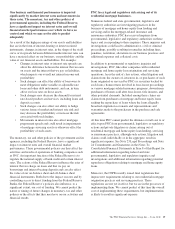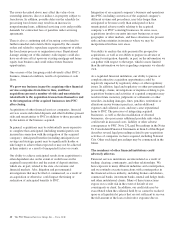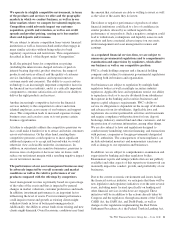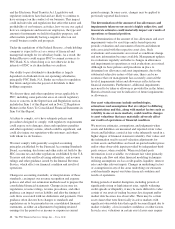PNC Bank 2012 Annual Report Download - page 31
Download and view the complete annual report
Please find page 31 of the 2012 PNC Bank annual report below. You can navigate through the pages in the report by either clicking on the pages listed below, or by using the keyword search tool below to find specific information within the annual report.ITEM
1A – R
ISK
F
ACTORS
We are subject to a number of risks potentially impacting our
business, financial condition, results of operations and cash
flows. As a financial services organization, certain elements of
risk are inherent in our transactions and are present in the
business decisions we make. Thus, we encounter risk as part
of the normal course of our business, and we design risk
management processes to help manage these risks.
There are risks that are known to exist at the outset of a
transaction. For example, every loan transaction presents
credit risk (the risk that the borrower may not perform in
accordance with contractual terms) and market risk (a
potential loss in earnings or economic value due to adverse
movement in market interest rates or credit spreads), with the
nature and extent of these risks principally depending on the
financial profile of the borrower and overall economic
conditions. We focus on lending that is within the boundaries
of our risk framework, and manage these risks by adjusting
the terms and structure of the loans we make and through our
oversight of the borrower relationship, as well as through
management of our deposits and other funding sources.
Risk management is an important part of our business model.
The success of our business is dependent on our ability to
identify, understand and manage the risks presented by our
business activities so that we can appropriately balance
revenue generation and profitability. These risks include, but
are not limited to, credit risk, market risk, liquidity risk,
operational risk, model risk, technology, compliance and legal
risk, and strategic and reputation risk. We discuss our
principal risk management processes and, in appropriate
places, related historical performance in the Risk Management
section included in Item 7 of this Report.
The following are the key risk factors that affect us. Any one
or more of these risk factors could have a material adverse
impact on our business, financial condition, results of
operations or cash flows, in addition to presenting other
possible adverse consequences, which are described below.
These risk factors and other risks are also discussed further in
other sections of this Report.
The possibility of the moderate economic recovery
returning to recessionary conditions or of turmoil or
volatility in the financial markets would likely have an
adverse effect on our business, financial position and
results of operations.
Although the United States economy has shown modest
improvement recently, economic conditions continue to pose a
risk to financial institutions, including PNC. The economic
recovery, although continuing, did so only at a pace in 2012
below trend for other recent recoveries from recessions. Job
growth has not yet been sufficient to significantly reduce high
unemployment in the United States. Consumer and business
confidence is improving but remains in the cautious zone.
There continues to be concern regarding the possibility of a
return to recessionary conditions, as well as regarding the
possibility of increased turmoil or volatility in financial
markets.
The recent global recession and disruption of the financial
markets has led to concerns over the solvency of certain
Eurozone states, including Greece, Ireland, Italy, Portugal and
Spain, affecting these countries’ capital markets access, as
well as market perception of financial institutions that have
significant direct or indirect exposure to these countries’
creditworthiness. Certain of the major rating agencies have
downgraded the sovereign credit ratings of Greece, Portugal
and Ireland to below investment grade. The sovereign credit
ratings of France, Italy and Spain have also been downgraded.
These ratings downgrades, uncertainties surrounding the
implementation of reform programs, the effect of economic
contraction, and the Eurozone’s financial inter-linkages
increase the risk of financial distress spreading to other
Eurozone states. If measures to address sovereign debt and
financial sector problems in Europe are inadequate, they may
result in a delayed economic recovery, the exit of one or more
member states from the Eurozone, or more severe
recessionary conditions. If realized, these risk scenarios could
contribute to severe financial market stress or a global
recession, likely affecting the economy and capital markets in
the United States as well.
Although the so-called “fiscal cliff” was averted in early 2013,
Congress and the President still need to resolve issues with
respect to the U.S. government’s debt ceiling and other
budgetary and spending matters. Uncertainty as to whether
these issues can be resolved or how effective a resolution
might be increases the risk of slower economic growth. The
nature and ultimate resolution of these issues, or a failure to
achieve a timely and effective resolution, may further
adversely affect the U.S. economy through possible
consequences including downgrades in the ratings for U.S.
Treasury securities, government shutdowns, or substantial
spending cuts resulting from sequestration.
Current economic conditions have had an adverse effect on
our business and financial performance and may not improve
in the near future. We expect these conditions to continue to
have an ongoing negative impact on us and a worsening of
conditions would likely aggravate the adverse effects of these
difficult economic and market conditions on us and on others
in the financial services industry.
In particular, we may face the following risks in connection
with the current economic and market environment:
• Investors may have less confidence in the equity
markets in general and in financial services industry
stocks in particular, which could place downward
pressure on PNC’s stock price and resulting market
valuation.
• Economic and market developments, in the United
States, Europe or elsewhere, may further affect
12 The PNC Financial Services Group, Inc. – Form 10-K


